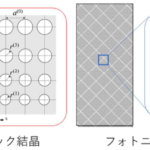2023-09-27 ウィスコンシン大学マディソン校,ワシントン大学セントルイス校,南カリフォルニア大学
◆この材料は、2023年9月20日に「Advanced Materials」誌に掲載されました。新しい材料はストロンチウムチタン硫化物(Sr9/8TiS3またはSTS)と呼ばれ、これまでの記録保持者であるバリウムチタン硫化物(BaTiS3またはBTS)の3倍の二重屈折を持っています。材料の微細な構造の変更により、光学特性に大きな変化が生じることが明らかになり、材料の光学応答をボタンを押すことで大きく変更できる可能性があります。
◆現在、合成方法はストロンチウムチタン硫化物の小さなフレークしか生成できませんが、これを大規模な単結晶材料にする可能性があります。また、この結晶のユニークな構造が分かったため、同様またはより強力な光学特性を持つ他の結晶を探索することも可能です。
<関連情報>
- https://engineering.wisc.edu/news/how-a-handful-of-stray-atoms-led-to-a-new-material-that-curves-light-in-a-record-setting-way/
- https://onlinelibrary.wiley.com/doi/10.1002/adma.202303588
原子レベルの変調による巨大な光学異方性 Colossal Optical Anisotropy from Atomic-Scale Modulations
Hongyan Mei, Guodong Ren, Boyang Zhao, Jad Salman, Gwan Yeong Jung, Huandong Chen, Shantanu Singh, Arashdeep S. Thind, John Cavin, Jordan A. Hachtel, Miaofang Chi, Shanyuan Niu, Graham Joe, Chenghao Wan, Nick Settineri, Simon J. Teat, Bryan C. Chakoumakos, Jayakanth Ravichandran, Rohan Mishra, Mikhail A. Kats
Advanced Materials Published: 02 August 2023
DOI:https://doi.org/10.1002/adma.202303588

Abstract
Materials with large birefringence (Δn, where n is the refractive index) are sought after for polarization control (e.g., in wave plates, polarizing beam splitters, etc.), nonlinear optics, micromanipulation, and as a platform for unconventional light–matter coupling, such as hyperbolic phonon polaritons. Layered 2D materials can feature some of the largest optical anisotropy; however, their use in most optical systems is limited because their optical axis is out of the plane of the layers and the layers are weakly attached. This work demonstrates that a bulk crystal with subtle periodic modulations in its structure—Sr9/8TiS3—is transparent and positive-uniaxial, with extraordinary index ne = 4.5 and ordinary index no = 2.4 in the mid- to far-infrared. The excess Sr, compared to stoichiometric SrTiS3, results in the formation of TiS6 trigonal-prismatic units that break the chains of face-sharing TiS6 octahedra in SrTiS3 into periodic blocks of five TiS6 octahedral units. The additional electrons introduced by the excess Sr form highly oriented electron clouds, which selectively boost the extraordinary index ne and result in record birefringence (Δn > 2.1 with low loss). The connection between subtle structural modulations and large changes in refractive index suggests new categories of anisotropic materials and also tunable optical materials with large refractive-index modulation.



